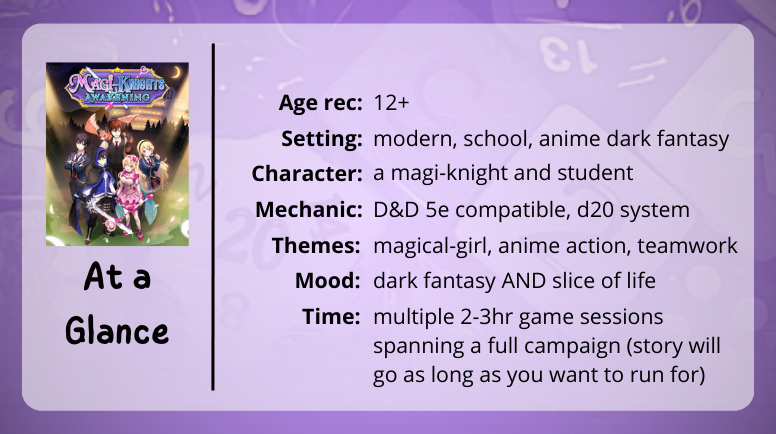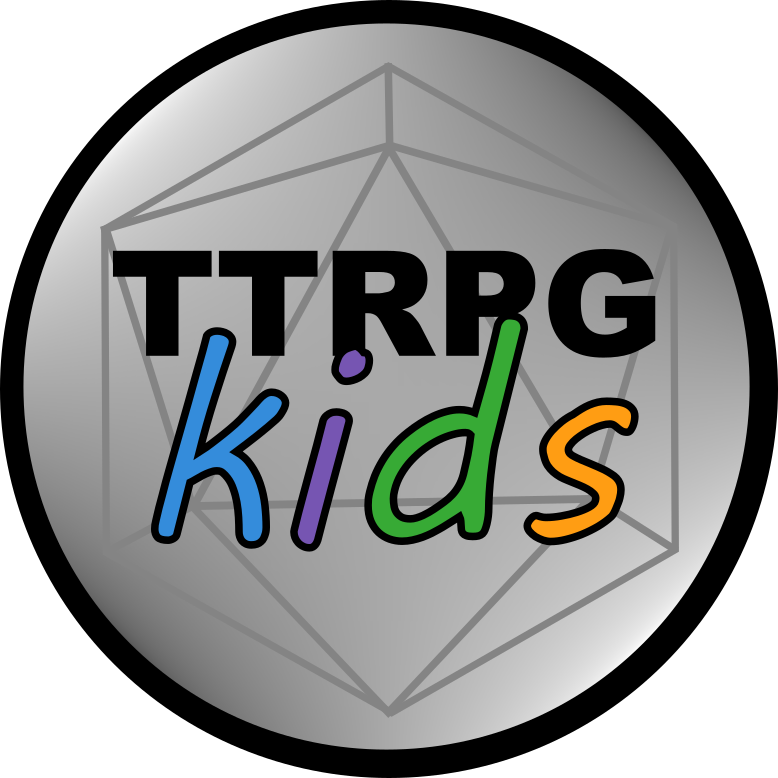Review: Magi-Knights, a 5e compatible magical-girl inspired TTRPG!
Note: This post may contain affiliate links. At no additional cost to you, I may earn a small commission from purchases made using them. TTRPGkids uses this to keep the site going. Read full disclosure here.
Jump to:

Magi-Knights is good for tweens and teens
Magi-Knights has similar complexity and themes to D&D, and it is set with characters going to an academy as teens with some teen drama vibes to go with it. It does have some themes associated with a dark fantasy story (i.e. potential for corruption or darkness and a bit of flair of some anime-style creepy creatures and baddies depending on how you want to run your campaign), so I think this game would be great for slightly older kids.

You create the story for your players, so you have control over the narrative and the content that you put into the game, so you can definitely modulate it to fit your player’s interests. It lends itself well to stories that follow the lines of anywhere from Sailor Moon to Persona to Madoka Magica depending on what you want to go for – there’s a lot of variation that you can build into your game.
And, I feel it is worth noting that while the genre that this seems to be the most reminiscent of is magical girl stories, this is NOT aimed at only feminine persons or characters. It’s titled Magi-Knights to include everyone and is not aimed at any particular gender.
Magi-Knights is set in a modern day world
Magi-Knights is set in a normal, modern day world… but with the Spectral Outsiders and Servants of Evil coming out at night (and only the Magi-Knights can stop them)!
Characters go to normal school, hang out with friends, and generally need to balance their life as a Magi-Knight with their life as a student while the world keeps turning, largely thanks to their efforts.
That doesn’t mean that life as a knight won’t spill over or interact with everyday life – students or family may get tangled up in the plots of the Servants of Evil, or the Spectral Outsiders could crash an evening festival. If players don’t manage their exhaustion, they could wear out and get detention or become corrupted. It is important and built into the mechanics for characters to live in both worlds.
This game does a really good job in connecting these two settings – there’s plenty to do with each, and they overlap constantly with core elements of both of the character’s worlds affecting and flowing into each other.
Your character in Magi-Knights

I mentioned that characters will need to live in both worlds, and to do that, as part of character creation, you make your Knight AND your student personas to be able to play both parts!
Your character starts out as a normal student who, in a moment of life-or-death, is saved by The Herald (a cute and probably very suspicious little entity) who turns them into a Magi-Knight to face off against the world’s unseen dangers! From that point on, your character lives two lives – that of a magical hero who can tap into their soul gem to unlock amazing powers and abilities and that of a student who needs to balance homework, quizzes, and relationships just like everyone else.
Mechanics in Magi-Knights
D&D compatible but with a whole new vibe
Magi-Knights is a full ~300 page rule book, so I won’t be able to cover EVERYTHING that I want to in this review (there’s a lot of really cool elements), but I will give the broad strokes.
This game is made to be D&D compatible, so things like stats, spell DC, skill checks, etc. are all the same, and it does go through and explain them for anyone who isn’t familiar with D&D rules.
From there, though, it makes a lot of interesting changes in how it handles classes, spells, items, and more.
The biggest foundational difference here is your mechanical character creation (backstory will be later). Instead of choosing a class and subclass and starting gear and etc, you choose a magic style, a spell path, an elemental affinity, and your soul armaments. This is where I think the complexity is about similar to D&D – it’s D&D compatible, but you aren’t adding a whole book onto D&D – you’re using this instead of the D&D core book. Character creation follows a similar path, but it’s named differently and is made to specifically fit the new theme.
Within all of these choices, it lets you mix and match abilities between 5 magic styles (ex: verse uses bardic-esque skills), 10 spell paths (ex: beam powers or curing), 5 elemental affinities (fire, void, etc), and the gear that you summon when you transform from a student to a Knight! You get a bit more flexibility to create a character that mechanically works how you want by combining these different aspects as you want.
Mana and soul gems
I just mentioned how Magi-Knights has a base similar to D&D, but now I want to talk about some of the detail differences that make this game really unique.
First, instead of tracking spell slots, Magi-Knights use mana points, which you calculate based on your Knight’s level, modifiers, reputation, etc. Then, your spells cost a certain amount of mana depending on their spell tier. So, a tier 1 spell costs 3 mana while a tier 6 spell costs 45 mana. Instead of tracking spell slots, everything comes from the same pool, which I really liked. You have a little more flexibility and cost/reward balance when you are deciding if you want to cast a whole bunch of small spells or save up for one really big one.

Second, instead of death saving throws, you have 7 facets of your soul gem that you’re watching. Every time you hit 0 HP, you’re attacked while unconscious, or you take a certain special move to push yourself, one of the facets cracks. If all of them crack and you take an 8th blow, your character dies. You can repair the gem by taking a sleep phase, using special high level curing magic, etc. I liked this change both because it gave a bit longer span than the normal 3 death saving throws AND because it lasts through the whole encounter (doesn’t reset when you get back up), so you don’t have a character going up and down and up and down on 1HP the whole encounter. The stakes are lower in some areas and higher in others, and I liked that balance shift.
Bonds and managing knight-student balancing

One of my favorite parts of Magi-Knights was that it creates a set of mechanics revolving around slice-of-life or downtime activities and maintaining relationships that affect your Knight abilities. It has RP built into the mechanics so that it isn’t going to just be fighting monsters or staying in Knight form all the time.
There’s a system for starting with an initial bond with a friend, family member, important teacher, etc in the beginning by drawing from a deck of cards to see who the key figures in your character’s life are. You also have bonds with your fellow Knights and potentially with The Herald, should you choose to try to make friends. These bonds grow when you spend time with each other during your downtime and support each other through the game… and it comes back to help! You unlock special abilities that help you in Knight form if you’re close friends with someone or maintain that relationship! This really reminded me of when I played Persona 5, and it was one of my favorite parts of that game, so it was very fun to see that built in here.
Magi-Knights also has school events and personal downtime built in. School events create some extra challenges and stress but can also be an opportunity to build bonds and find interesting plot hooks. Downtime, like going to the mall or taking a moment of catharsis, are also often very required for your character, not just for building bonds, but for making sure your character isn’t getting overwhelmed. Being a Knight is hard and so is being a student, so you can take this time to handle trauma points that have banked up, earn shards (special items), get inspiration, and so on that all help you as a Knight too.
Overall thoughts on Magi-Knights

I thought Magi-Knights was a really clever way to reinvent D&D, and it really captured the vibe of a lot of the anime and JRPG games that I’m familiar with in digital form. It took me a bit to break down my perception of character creation from D&D and see how this one shifted it, but once I did, I really liked this method because it offered quite a bit more flexibility AND it built in some really solid RP to the character that is kind of assumed in D&D but isn’t really built into the mechanics. Having RP mechanics that feed back into the “combat and encounter” side of the character was an interesting and fun way to help players who are maybe new to RP-style games or tend to get very invested in combat to give RP a try. For those who like RP already, it gives them an opportunity to use that interest and skill to support the mechanics side of the game now too – their bonds and social development have more impact now! I really liked this rewrite, and, while I couldn’t play it with kiddo quite yet, I want to play it for myself and think it would be great for tweens and teens who are into anime and want to play a character that is the same age as them in a setting that they can recognize and connect with.
Find a copy of Magi-Knights
You can find a copy of Magi-Knights on DriveThruRPG!
If you liked this post, make sure to subscribe to the TTRPGkids monthly newsletter to stay up to date on the latest reviews, tips and tricks, game and podcast list updates, and more! Thank you for playing tabletop RPGs with your kids and sharing this awesome hobby with the next generation!



What a great review, thank you!! ? You focused on very different aspects of the game than we’ve seen in other feedback, so it was great to hear your thoughts. You also truly understood what we were going for in the themes and the RP mechanics, so we appreciate you passing that on by sharing it here! Thank you so much!
Thank you! I’m happy I hit the mark with the review, and I’m glad to review an awesome game like this.